QuickOSSE Research on the Impact of Airship-Borne Doppler Radar Radial Winds to Predict the Track and Intensity of a Tropical Cyclone
Abstract
1. Introduction
2. Method
2.1. Model and Data Assimilation Configuration
2.2. Nature Run
- (1)
- The horizontal resolution of the nature run (2 km) is nearly half that in the EnKF/noDA experiment (4.5 km);
- (2)
- The model top altitude, number of vertical levels, and sigma value of each model level in terrain-following coordinates differ between the twin experiments;
- (3)
- The initial and boundary condition of the nature run comes from the NCEP GFS forecast (with a resolution) that started at 18:00 UTC on 25 October 2020, whereas the NCEP FNL (with a resolution) is adopted in the EnKF/noDA experiment, and its initial time is 6 h later than the nature run;
- (4)
- Two vortex-following inner domains (d02/d03) are implemented in the nature run throughout the simulation period. The inner domains of the EnKF/noDA experiment remain static during the ensemble spin-up period and move with TC in the 42-h deterministic forecast.
2.3. Case Description
3. Impacts of the Simulated Observations
3.1. Simulation of the Airship-Borne Doppler Wind Observations
3.2. Impacts on TC Track and Intensity
3.3. Impacts on TC Structure
4. Sensitivity Analysis to Storm-Relative Distance and Radar Depression Angle
4.1. Simulated Observations under Various Conditions
4.2. Sensitivity Analysis
5. Summary and Discussion
Author Contributions
Funding
Data Availability Statement
Acknowledgments
Conflicts of Interest
References
- Huang, X.; Peng, X.; Fei, J.; Cheng, X.; Ding, J.; Yu, D. Evaluation and Error Analysis of Official Tropical Cyclone Intensity Forecasts during 2005–2018 for the Western North Pacific. J. Meteorol. Soc. Jpn. Ser. II 2021, 99, 139–163. [Google Scholar] [CrossRef]
- Li, Y.; Wang, Y.; Tan, Z.M. Why Does the Initial Wind Profile Inside the Radius of Maximum Wind Matter to Tropical Cyclone Development? J. Geophys. Res.-Atmos. 2022, 127, e2022JD037039. [Google Scholar] [CrossRef]
- Li, Y.; Wang, Y.; Lin, Y. Revisiting the Dynamics of Eyewall Contraction of Tropical Cyclones. J. Atmos. Sci. 2019, 76, 3229–3245. [Google Scholar] [CrossRef]
- Ryglicki, D.R.; Doyle, J.D.; Jin, Y.; Hodyss, D.; Cossuth, J.H. The Unexpected Rapid Intensification of Tropical Cyclones in Moderate Vertical Wind Shear. Part II: Vortex Tilt. Mon. Weather Rev. 2018, 146, 3801–3825. [Google Scholar] [CrossRef]
- Fei, R.; Wang, Y. Tropical Cyclone Intensification Simulated in the Ooyama-type Three-layer Model with a Multilevel Boundary Layer. J. Atmos. Sci. 2021, 78, 3799–3813. [Google Scholar] [CrossRef]
- Deng, L.; Gao, W.; Duan, Y.; Wang, Y. Microphysical Properties of Rainwater in Typhoon Usagi (2013): A Numerical Modeling Study. Adv. Atmos. Sci. 2019, 36, 510–526. [Google Scholar] [CrossRef]
- Holland, G.J. An Analytic Model of the Wind and Pressure Profiles in Hurricanes. Mon. Weather Rev. 1980, 108, 1212–1218. [Google Scholar] [CrossRef]
- Rappin, E.D.; Nolan, D.S.; Majumdar, S.J. A Highly Configurable Vortex Initialization Method for Tropical Cyclones. Mon. Weather Rev. 2013, 141, 3556–3575. [Google Scholar] [CrossRef]
- Kwon, I.-H.; Cheong, H.-B. Tropical Cyclone Initialization with a Spherical High-Order Filter and an Idealized Three-Dimensional Bogus Vortex. Mon. Weather Rev. 2010, 138, 1344–1367. [Google Scholar] [CrossRef]
- Cha, D.-H.; Wang, Y. A Dynamical Initialization Scheme for Real-Time Forecasts of Tropical Cyclones Using the WRF Model. Mon. Weather Rev. 2013, 141, 964–986. [Google Scholar] [CrossRef]
- Liu, H.-Y.; Wang, Y.; Xu, J.; Duan, Y. A Dynamical Initialization Scheme for Tropical Cyclones under the Influence of Terrain. Weather Forecast. 2018, 33, 641–659. [Google Scholar] [CrossRef]
- Shi, D.; Chen, G.; Wang, K.; Bi, X.; Chen, K. Evaluation of Two Initialization Schemes for Simulating the Rapid Intensification of Typhoon Lekima (2019). Adv. Atmos. Sci. 2020, 37, 987–1006. [Google Scholar] [CrossRef]
- Wu, C.C.; Chen, S.G.; Yang, C.C.; Lin, P.H.; Aberson, S.D. Potential Vorticity Diagnosis of the Factors Affecting the Track of Typhoon Sinlaku (2008) and the Impact from Dropwindsonde Data during T-PARC. Mon. Weather Rev. 2012, 140, 2670–2688. [Google Scholar] [CrossRef]
- Feng, J.; Wang, X. Impact of Assimilating Upper-Level Dropsonde Observations Collected during the TCI Field Campaign on the Prediction of Intensity and Structure of Hurricane Patricia (2015). Mon. Weather Rev. 2019, 147, 3069–3089. [Google Scholar] [CrossRef]
- Zhang, S.; Pu, Z. Numerical Simulation of Rapid Weakening of Hurricane Joaquin with Assimilation of High-Definition Sounding System Dropsondes during the Tropical Cyclone Intensity Experiment: Comparison of Three- and Four-Dimensional Ensemble–Variational Data Assimilation. Weather Forecast. 2019, 34, 521–538. [Google Scholar] [CrossRef]
- Zhang, F.; Minamide, M.; Nystrom, R.G.; Chen, X.; Lin, S.-J.; Harris, L.M. Improving Harvey Forecasts with Next-Generation Weather Satellites: Advanced Hurricane Analysis and Prediction with Assimilation of GOES-R All-Sky Radiances. Bull. Am. Meteorol. Soc. 2019, 100, 1217–1222. [Google Scholar] [CrossRef]
- Honda, T.; Miyoshi, T.; Lien, G.-Y.; Nishizawa, S.; Yoshida, R.; Adachi, S.A.; Terasaki, K.; Okamoto, K.; Tomita, H.; Bessho, K. Assimilating All-Sky Himawari-8 Satellite Infrared Radiances: A Case of Typhoon Soudelor (2015). Mon. Weather Rev. 2018, 146, 213–229. [Google Scholar] [CrossRef]
- Zhu, Y.; Liu, E.; Mahajan, R.; Thomas, C.; Groff, D.; Van Delst, P.; Collard, A.; Kleist, D.; Treadon, R.; Derber, J.C. All-Sky Microwave Radiance Assimilation in NCEP’s GSI Analysis System. Mon. Weather Rev. 2016, 144, 4709–4735. [Google Scholar] [CrossRef]
- Grasso, L.D.; Zupanski, M.; Wu, T.-C.; Kummerow, C.D.; Boukabara, S.-A. All-Sky Radiance Assimilation of ATMS in HWRF: A Demonstration Study. Mon. Weather Rev. 2019, 147, 85–106. [Google Scholar] [CrossRef]
- Feng, J.; Qin, X.; Wu, C.; Zhang, P.; Yang, L.; Shen, X.; Han, W.; Liu, Y. Improving typhoon predictions by assimilating the retrieval of atmospheric temperature profiles from the FengYun-4A’s Geostationary Interferometric Infrared Sounder (GIIRS). Atmos. Res. 2022, 280, 106488. [Google Scholar] [CrossRef]
- Lu, J.; Feng, T.; Li, J.; Cai, Z.; Xu, X.; Li, L.; Li, J. Impact of Assimilating Himawari-8-Derived Layered Precipitable Water With Varying Cumulus and Microphysics Parameterization Schemes on the Simulation of Typhoon Hato. J. Geophys. Res.-Atmos. 2019, 124, 3050–3071. [Google Scholar] [CrossRef]
- Velden, C.; Lewis, W.E.; Bresky, W.; Stettner, D.; Daniels, J.; Wanzong, S. Assimilation of High-Resolution Satellite-Derived Atmospheric Motion Vectors: Impact on HWRF Forecasts of Tropical Cyclone Track and Intensity. Mon. Weather Rev. 2017, 145, 1107–1125. [Google Scholar] [CrossRef]
- Pu, Z.; Yu, C.; Tallapragada, V.; Jin, J.; McCarty, W. The Impact of Assimilation of GPM Microwave Imager Clear-Sky Radiance on Numerical Simulations of Hurricanes Joaquin (2015) and Matthew (2016) with the HWRF Model. Mon. Weather Rev. 2019, 147, 175–198. [Google Scholar] [CrossRef]
- Wang, Y.; Pu, Z. Assimilation of Radial Velocity from Coastal NEXRAD into HWRF for Improved Forecasts of Landfalling Hurricanes. Weather Forecast. 2021, 36, 587–599. [Google Scholar] [CrossRef]
- Zhang, Z.; Zhang, J.A.; Alaka, G.J.; Wu, K.; Mehra, A.; Tallapragada, V. A Statistical Analysis of High-Frequency Track and Intensity Forecasts from NOAA’s Operational Hurricane Weather Research and Forecasting (HWRF) Modeling System. Mon. Weather Rev. 2021, 149, 3325–3339. [Google Scholar] [CrossRef]
- Shen, F.; Xu, D.; Min, J. Effect of momentum control variables on assimilating radar observations for the analysis and forecast for Typhoon Chanthu (2010). Atmos. Res. 2019, 230, 104622. [Google Scholar] [CrossRef]
- Shen, F.; Xu, D.; Min, J.; Chu, Z.; Li, X. Assimilation of radar radial velocity data with the WRF hybrid 4DEnVar system for the prediction of hurricane Ike (2008). Atmos. Res. 2020, 234, 104771. [Google Scholar] [CrossRef]
- Zhu, L.; Wan, Q.; Shen, X.; Meng, Z.; Zhang, F.; Weng, Y.; Sippel, J.; Gao, Y.; Zhang, Y.; Yue, J. Prediction and Predictability of High-Impact Western Pacific Landfalling Tropical Cyclone Vicente (2012) through Convection-Permitting Ensemble Assimilation of Doppler Radar Velocity. Mon. Weather Rev. 2016, 144, 21–43. [Google Scholar] [CrossRef]
- Xu, D.; Shen, F.; Min, J. Effect of background error tuning on assimilating radar radial velocity observations for the forecast of hurricane tracks and intensities. Meteorol. Appl. 2019, 27, e1820. [Google Scholar] [CrossRef]
- Xu, D.; Shen, F.; Min, J. Effect of Adding Hydrometeor Mixing Ratios Control Variables on Assimilating Radar Observations for the Analysis and Forecast of a Typhoon. Atmosphere 2019, 10, 415. [Google Scholar] [CrossRef]
- Duan, Y.; Wan, Q.; Huang, J.; Zhao, K.; Yu, H.; Wang, Y.; Zhao, D.; Feng, J.; Tang, J.; Chen, P.; et al. Landfalling Tropical Cyclone Research Project (LTCRP) in China. Bull. Am. Meteorol. Soc. 2019, 100, ES447–ES472. [Google Scholar] [CrossRef]
- Feng, J.; Duan, Y.; Wan, Q.; Hu, H.; Pu, Z. Improved Prediction of Landfalling Tropical Cyclone in China Based on Assimilation of Radar Radial Winds with New Super-Observation Processing. Weather Forecast. 2020, 35, 2523–2539. [Google Scholar] [CrossRef]
- Aberson, S.D.; Black, M.L.; Black, R.A.; Burpee, R.W.; Cione, J.J.; Landsea, C.W.; Marks, F.D. Thirty Years of Tropical Cyclone Research with the Noaa P-3 Aircraft. Bull. Am. Meteorol. Soc. 2006, 87, 1039–1056. [Google Scholar] [CrossRef]
- Weng, Y.; Zhang, F. Assimilating Airborne Doppler Radar Observations with an Ensemble Kalman Filter for Convection-Permitting Hurricane Initialization and Prediction: Katrina (2005). Mon. Weather Rev. 2012, 140, 841–859. [Google Scholar] [CrossRef]
- Zhang, F.; Weng, Y.; Gamache, J.F.; Marks, F.D. Performance of convection-permitting hurricane initialization and prediction during 2008-2010 with ensemble data assimilation of inner-core airborne Doppler radar observations. Geophys. Res. Lett. 2011, 38, L15810. [Google Scholar] [CrossRef]
- Zhang, F.; Weng, Y. Predicting Hurricane Intensity and Associated Hazards: A Five-Year Real-Time Forecast Experiment with Assimilation of Airborne Doppler Radar Observations. Bull. Am. Meteorol. Soc. 2015, 96, 25–33. [Google Scholar] [CrossRef]
- Gray, W.M.; Neumann, C.; Tsui, T.L. Assessment of the Role of Aircraft Reconnaissance on Tropical Cyclone Analysis and Forecasting. Bull. Am. Meteorol. Soc. 1991, 72, 1867–1883. [Google Scholar] [CrossRef]
- Weatherford, C.L.; Gray, W.M. Typhoon Structure as Revealed by Aircraft Reconnaissance. Part I: Data Analysis and Climatology. Mon. Weather Rev. 1988, 116, 1032–1043. [Google Scholar] [CrossRef]
- Weatherford, C.L.; Gray, W.M. Typhoon Structure as Revealed by Aircraft Reconnaissance. Part II: Structural Variability. Mon. Weather Rev. 1988, 116, 1044–1056. [Google Scholar] [CrossRef]
- Chou, K.-H.; Wu, C.-C.; Lin, P.-H.; Aberson, S.D.; Weissmann, M.; Harnisch, F.; Nakazawa, T. The Impact of Dropwindsonde Observations on Typhoon Track Forecasts in DOTSTAR and T-PARC. Mon. Weather Rev. 2011, 139, 1728–1743. [Google Scholar] [CrossRef]
- Liu, C.; Xue, M.; Kong, R. Direct Assimilation of Radar Reflectivity Data Using 3DVAR: Treatment of Hydrometeor Background Errors and OSSE Tests. Mon. Weather Rev. 2019, 147, 17–29. [Google Scholar] [CrossRef]
- Zeng, X.; Atlas, R.; Birk, R.J.; Carr, F.H.; Carrier, M.J.; Cucurull, L.; Hooke, W.H.; Kalnay, E.; Murtugudde, R.; Posselt, D.J.; et al. Use of Observing System Simulation Experiments in the United States. Bull. Am. Meteorol. Soc. 2020, 101, E1427–E1438. [Google Scholar] [CrossRef]
- Leidner, S.M.; Nehrkorn, T.; Henderson, J.; Mountain, M.; Yunck, T.; Hoffman, R.N. A Severe Weather Quick Observing System Simulation Experiment (QuickOSSE) of Global Navigation Satellite System (GNSS) Radio Occultation (RO) Superconstellations. Mon. Weather Rev. 2017, 145, 637–651. [Google Scholar] [CrossRef]
- Zhang, F.; Minamide, M.; Clothiaux, E.E. Potential impacts of assimilating all-sky infrared satellite radiances from GOES-R on convection-permitting analysis and prediction of tropical cyclones. Geophys. Res. Lett. 2016, 43, 2954–2963. [Google Scholar] [CrossRef]
- Pan, S.; Gao, J.; Stensrud, D.J.; Wang, X.; Jones, T.A. Assimilation of Radar Radial Velocity and Reflectivity, Satellite Cloud Water Path, and Total Precipitable Water for Convective-Scale NWP in OSSEs. J. Atmos. Ocean. Technol. 2018, 35, 67–89. [Google Scholar] [CrossRef]
- Delgado, J.; Bucci, L.; Ryan, K.; Atlas, R.; Murillo, S. Impact of Gulfstream-IV Dropsondes on Tropical Cyclone Prediction in a Regional OSSE System. Mon. Weather Rev. 2019, 147, 2961–2977. [Google Scholar] [CrossRef]
- Hoffman, R.N.; Atlas, R. Future Observing System Simulation Experiments. Bull. Am. Meteorol. Soc. 2016, 97, 1601–1616. [Google Scholar] [CrossRef]
- Atlas, R.; Bucci, L.; Annane, B.; Hoffman, R.; Murillo, S. Observing System Simulation Experiments to Assess the Potential Impact of New Observing Systems on Hurricane Forecasting. Mar. Technol. Soc. J. 2015, 49, 140–148. [Google Scholar] [CrossRef]
- Noh, Y.; Cheon, W.G.; Hong, S.Y.; Raasch, S. Improvement of the K-profile Model for the Planetary Boundary Layer based on Large Eddy Simulation Data. Bound.-Layer Meteorol. 2003, 107, 401–427. [Google Scholar] [CrossRef]
- Mlawer, E.J.; Taubman, S.J.; Brown, P.D.; Iacono, M.J.; Clough, S.A. Radiative transfer for inhomogeneous atmospheres: RRTM, a validated correlated-k model for the longwave. J. Geophys. Res.-Atmos. 1997, 102, 16663–16682. [Google Scholar] [CrossRef]
- Dudhia, J. Numerical Study of Convection Observed during the Winter Monsoon Experiment Using a Mesoscale Two-Dimensional Model. J. Atmos. Sci. 1988, 46, 3077–3107. [Google Scholar] [CrossRef]
- Hong, S.-Y.; Dudhia, J.; Chen, S.-H. A Revised Approach to Ice Microphysical Processes for the Bulk Parameterization of Clouds and Precipitation. Mon. Weather Rev. 2004, 132, 103–120. [Google Scholar] [CrossRef]
- Kain, J.S. The Kain–Fritsch Convective Parameterization: An Update. J. Appl. Meteorol. 2004, 43, 170–181. [Google Scholar] [CrossRef]
- Zhang, F.; Weng, Y.; Sippel, J.A.; Meng, Z.; Bishop, C.H. Cloud-Resolving Hurricane Initialization and Prediction through Assimilation of Doppler Radar Observations with an Ensemble Kalman Filter. Mon. Weather Rev. 2009, 137, 2105–2125. [Google Scholar] [CrossRef]
- Yue, J.; Meng, Z. Impact of assimilating Taiwan’s coastal radar radial velocity on forecasting Typhoon Morakot (2009) in southeastern China using a WRF-based EnKF. Sci. China Earth Sci. 2017, 60, 315–327. [Google Scholar] [CrossRef]
- Yue, J.; Meng, Z.; Yu, C.-K.; Cheng, L.-W. Impact of coastal radar observability on the forecast of the track and rainfall of Typhoon Morakot (2009) using WRF-based ensemble Kalman filter data assimilation. Adv. Atmos. Sci. 2017, 34, 66–78. [Google Scholar] [CrossRef]
- Zhang, X.; Duan, Y.; Wang, Y.; Wei, N.; Hu, H. A high-resolution simulation of Supertyphoon Rammasun (2014)—Part I: Model verification and surface energetics analysis. Adv. Atmos. Sci. 2017, 34, 757–770. [Google Scholar] [CrossRef]
- Wang, H.; Wang, Y. A Numerical Study of Typhoon Megi (2010). Part I: Rapid Intensification. Mon. Weather Rev. 2014, 142, 29–48. [Google Scholar] [CrossRef]
- Wang, H.; Wang, Y.; Xu, H. Improving simulation of a tropical cyclone using dynamical initialization and large-scale spectral nudging: A case study of Typhoon Megi (2010). Acta Meteorol. Sin. 2013, 27, 455–475. [Google Scholar] [CrossRef]
- Xu, H.; Wang, H.; Duan, Y. An Investigation of the Impact of Different Turbulence Schemes on the Tropical Cyclone Boundary Layer at Turbulent Gray-Zone Resolution. J. Geophys. Res.-Atmos. 2021, 126, e2021JD035327. [Google Scholar] [CrossRef]
- Aksoy, A.; Lorsolo, S.; Vukicevic, T.; Sellwood, K.J.; Aberson, S.D.; Zhang, F. The HWRF Hurricane Ensemble Data Assimilation System (HEDAS) for High-Resolution Data: The Impact of Airborne Doppler Radar Observations in an OSSE. Mon. Weather Rev. 2012, 140, 1843–1862. [Google Scholar] [CrossRef]
- Spilhaus, A.F. Raindrop size, shape and falling speed. J. Atmos. Sci. 1948, 5, 108–110. [Google Scholar] [CrossRef]
- Lippi, D.E.; Carley, J.R.; Kleist, D.T. Improvements to the Assimilation of Doppler Radial Winds for Convection-Permitting Forecasts of a Heavy Rain Event. Mon. Weather Rev. 2019, 147, 3609–3632. [Google Scholar] [CrossRef]
- Sun, J.; Crook, N.A. Dynamical and Microphysical Retrieval from Doppler Radar Observations Using a Cloud Model and Its Adjoint. Part II: Retrieval Experiments of an Observed Florida Convective Storm. J. Atmos. Sci. 1998, 55, 835–852. [Google Scholar] [CrossRef]
- Maldonado, P.; Ruiz, J.; Saulo, C. Parameter sensitivity of the WRF-LETKF system for assimilation of radar observations: Imperfect-model observing system simulation experiments. Weather Forecast. 2020, 35, 1345–1362. [Google Scholar] [CrossRef]
- Waller, J.A.; Bauernschubert, E.; Dance, S.L.; Nichols, N.K.; Potthast, R.; Simonin, D. Observation Error Statistics for Doppler Radar Radial Wind Superobservations Assimilated into the DWD COSMO-KENDA System. Mon. Weather Rev. 2019, 147, 3351–3364. [Google Scholar] [CrossRef]
- Munsell, E.B.; Zhang, F.; Braun, S.A.; Sippel, J.A.; Didlake, A.C. The Inner-Core Temperature Structure of Hurricane Edouard (2014): Observations and Ensemble Variability. Mon. Weather Rev. 2018, 146, 135–155. [Google Scholar] [CrossRef]
- Zhang, D.-L.; Chen, H. Importance of the upper-level warm core in the rapid intensification of a tropical cyclone. Geophys. Res. Lett. 2012, 39, L02806. [Google Scholar] [CrossRef]
- Gao, S.; Wang, D.; Hong, H.; Wu, N.; Li, T. Evaluation of Warm-Core Structure in Reanalysis and Satellite Data Sets Using HS3 Dropsonde Observations: A Case Study of Hurricane Edouard (2014). J. Geophys. Res.-Atmos. 2018, 123, 6713–6731. [Google Scholar] [CrossRef]
- Wang, X.; Jiang, H. A 13-Year Global Climatology of Tropical Cyclone Warm-Core Structures from AIRS Data. Mon. Weather Rev. 2019, 147, 773–790. [Google Scholar] [CrossRef]
- Emanuel, K.; Zhang, F. On the Predictability and Error Sources of Tropical Cyclone Intensity Forecasts. J. Atmos. Sci. 2016, 73, 3739–3747. [Google Scholar] [CrossRef]


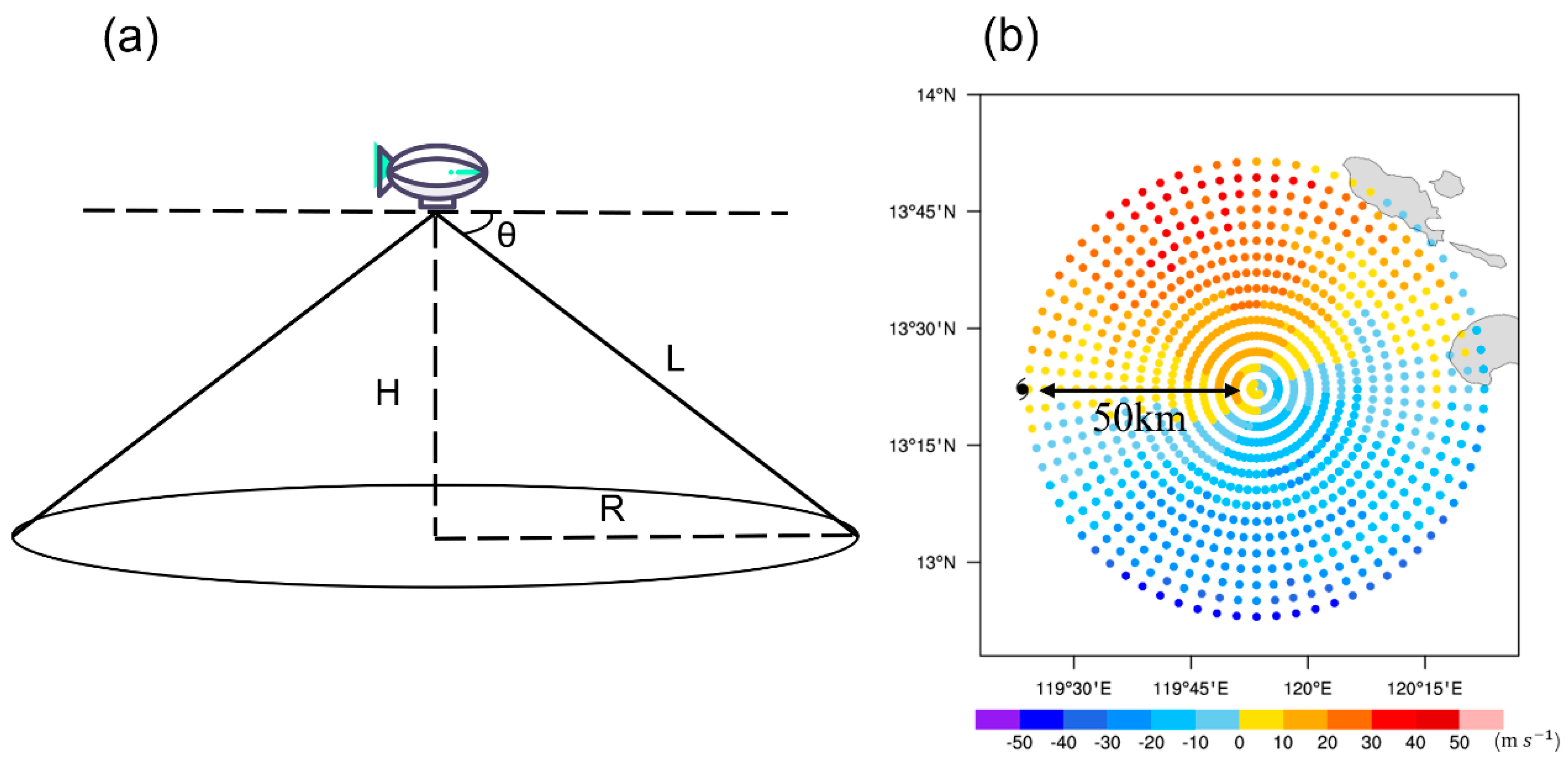
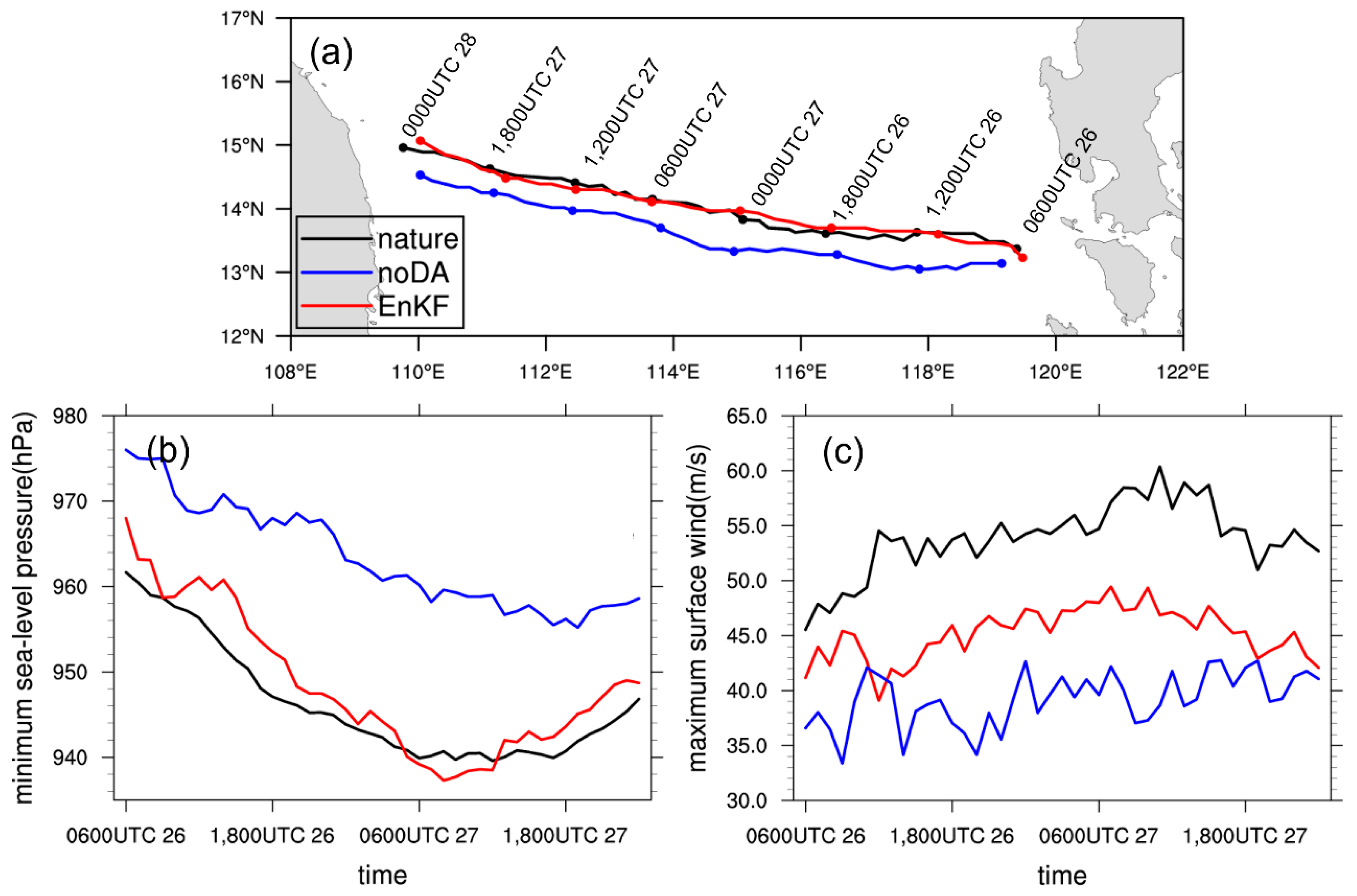
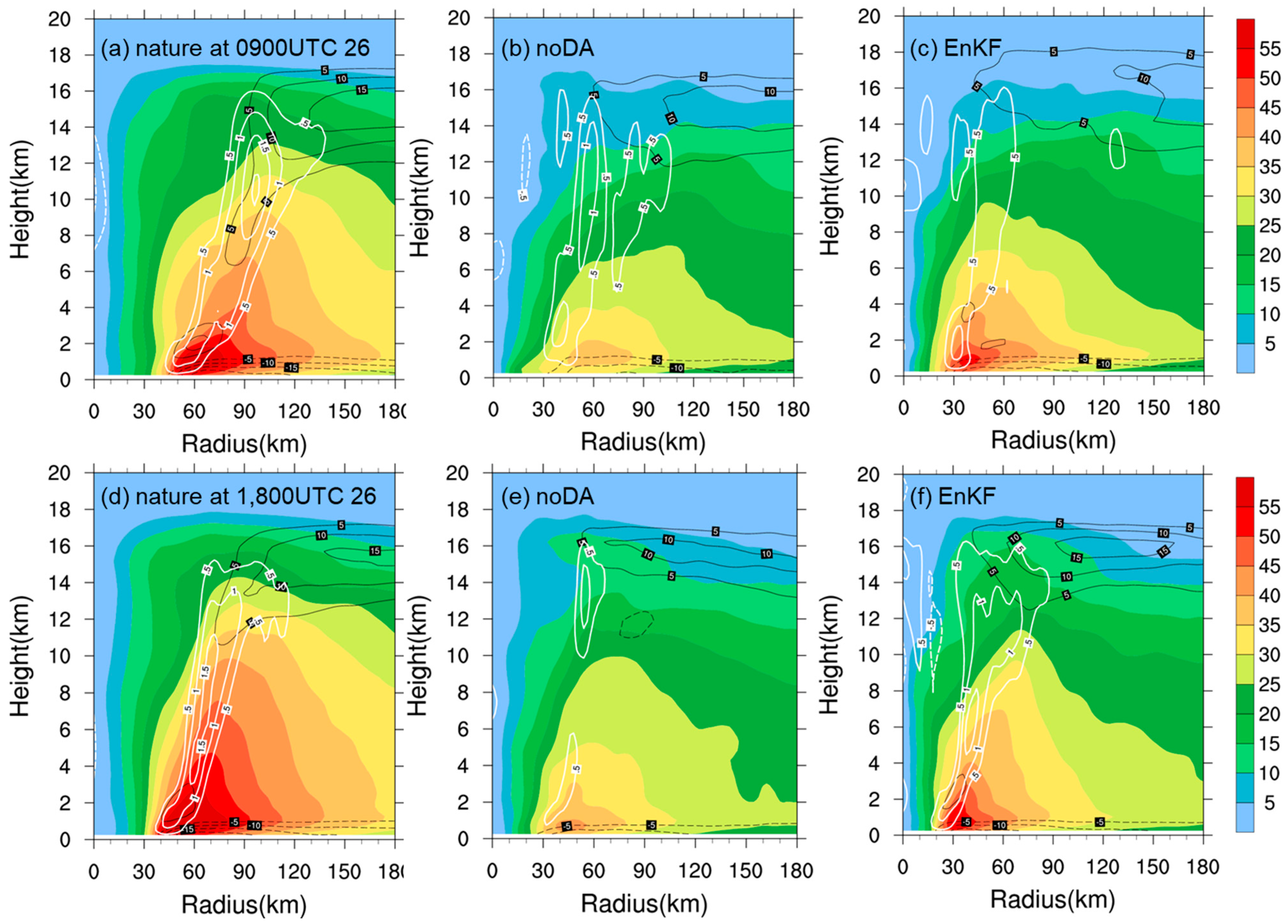
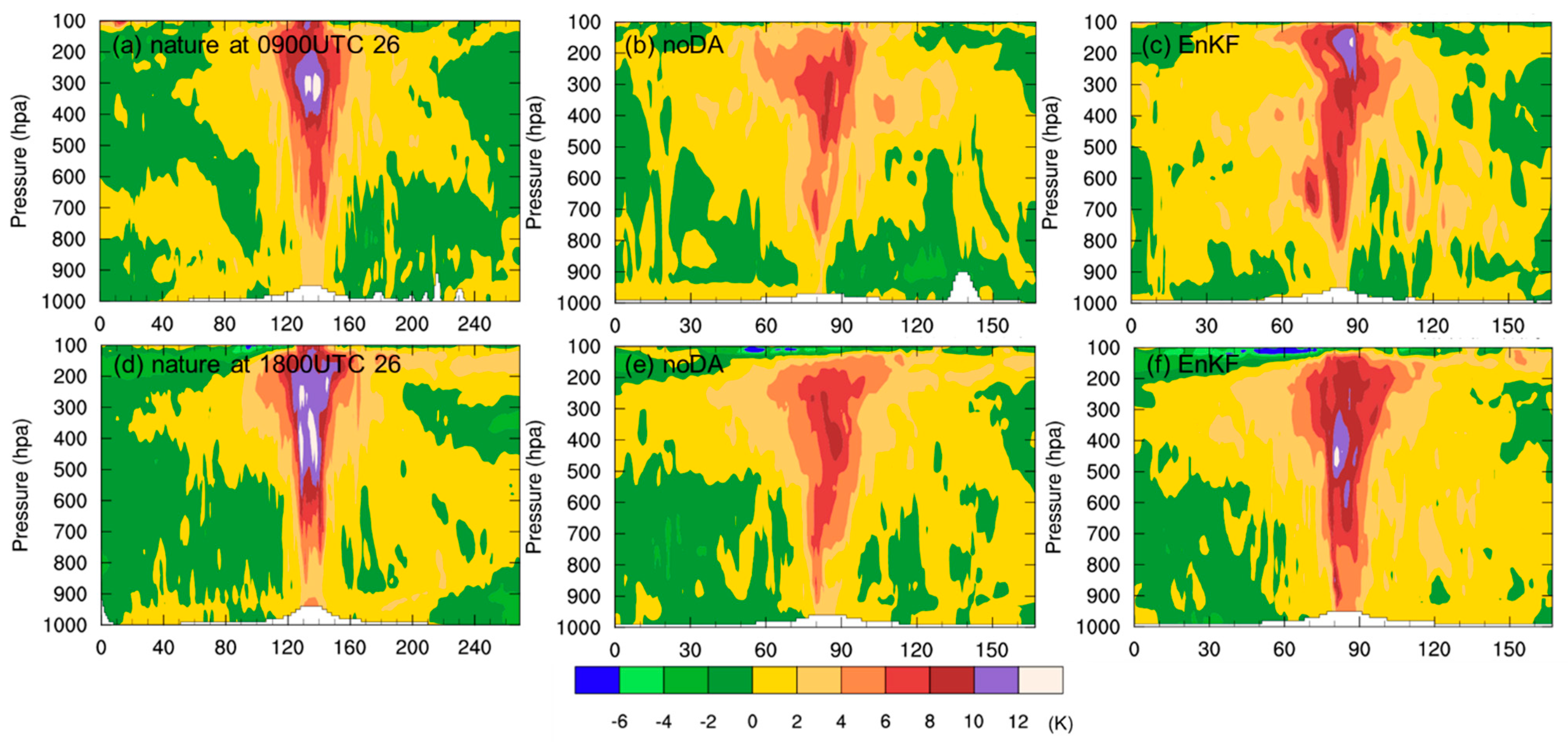
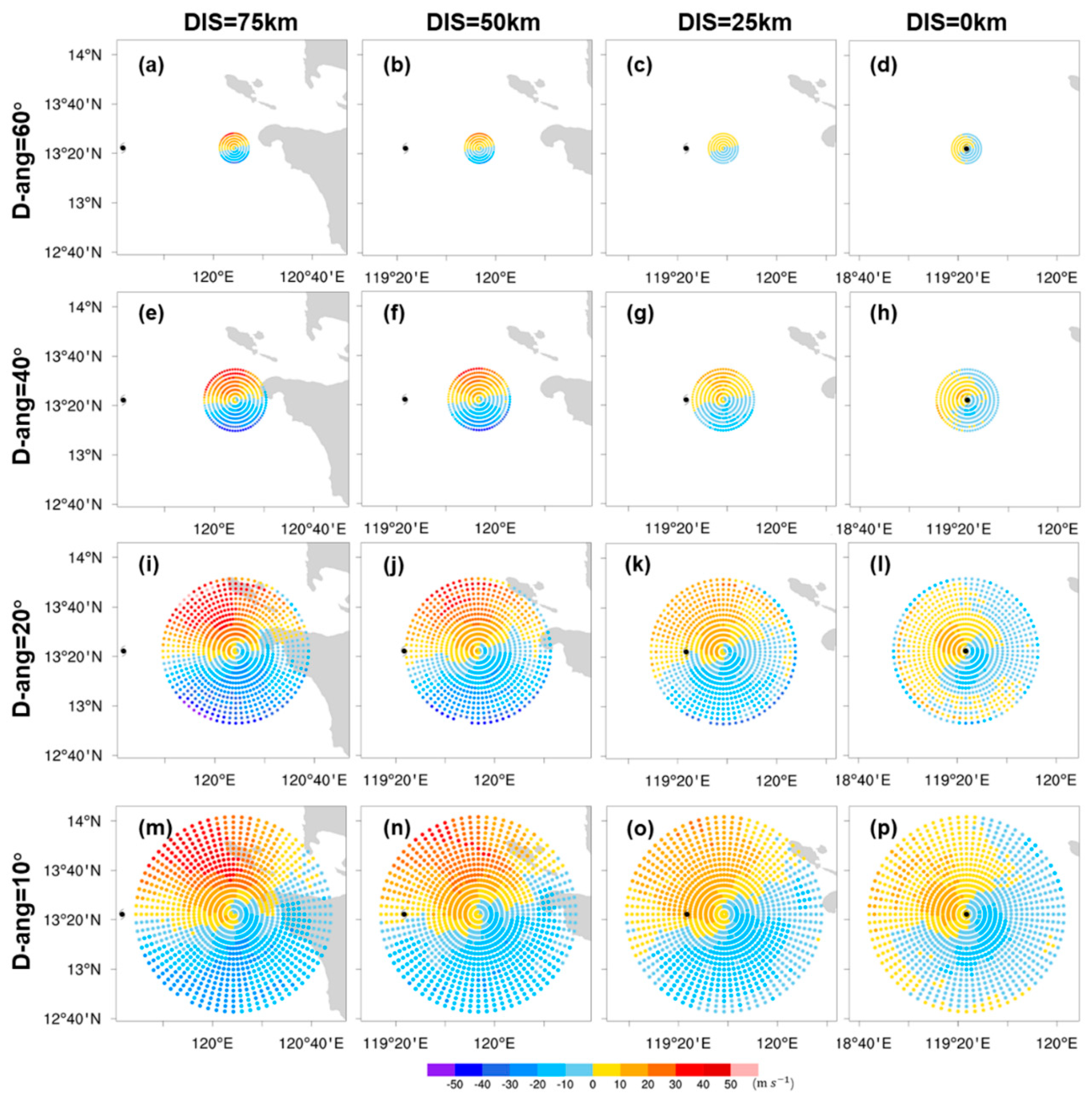
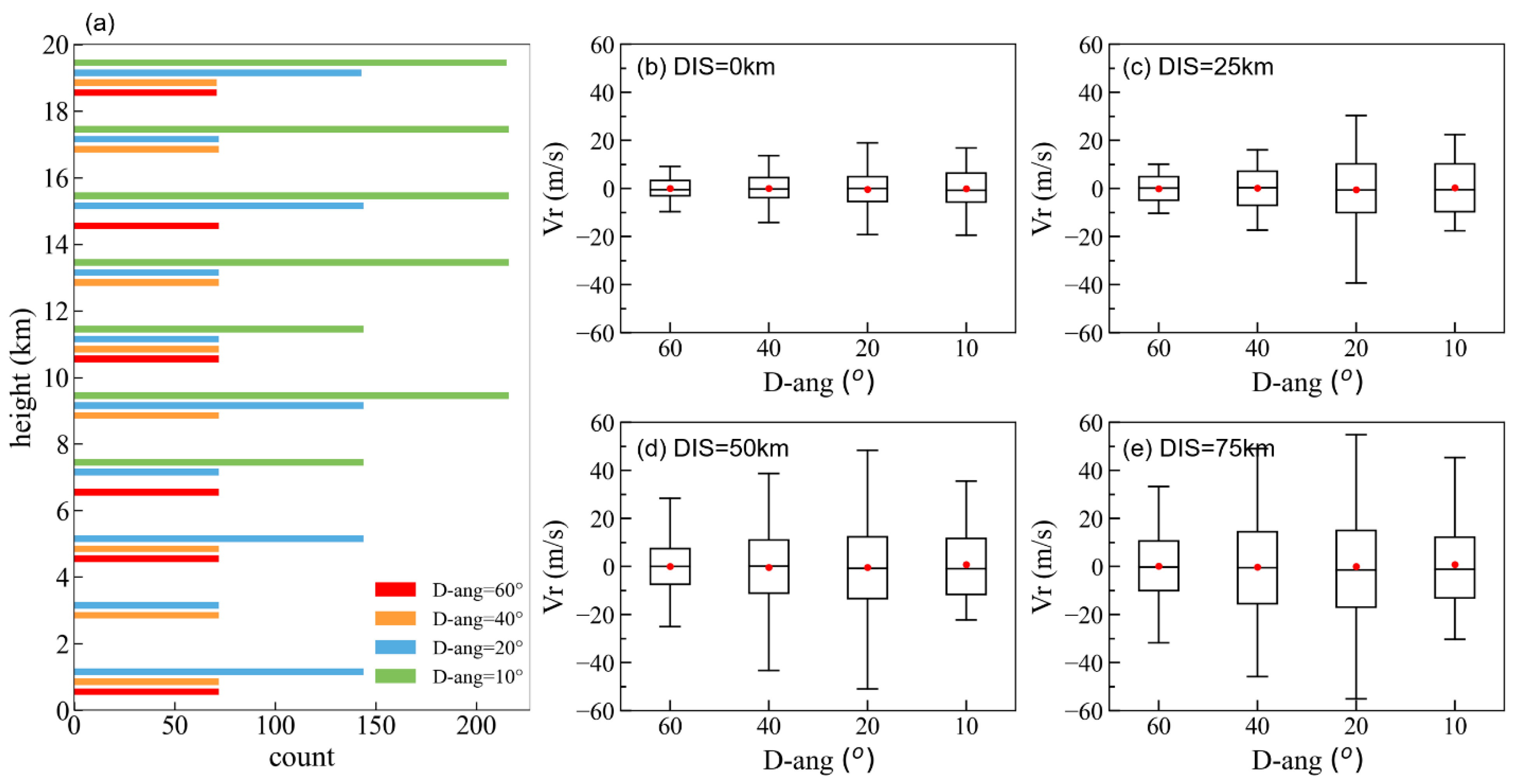
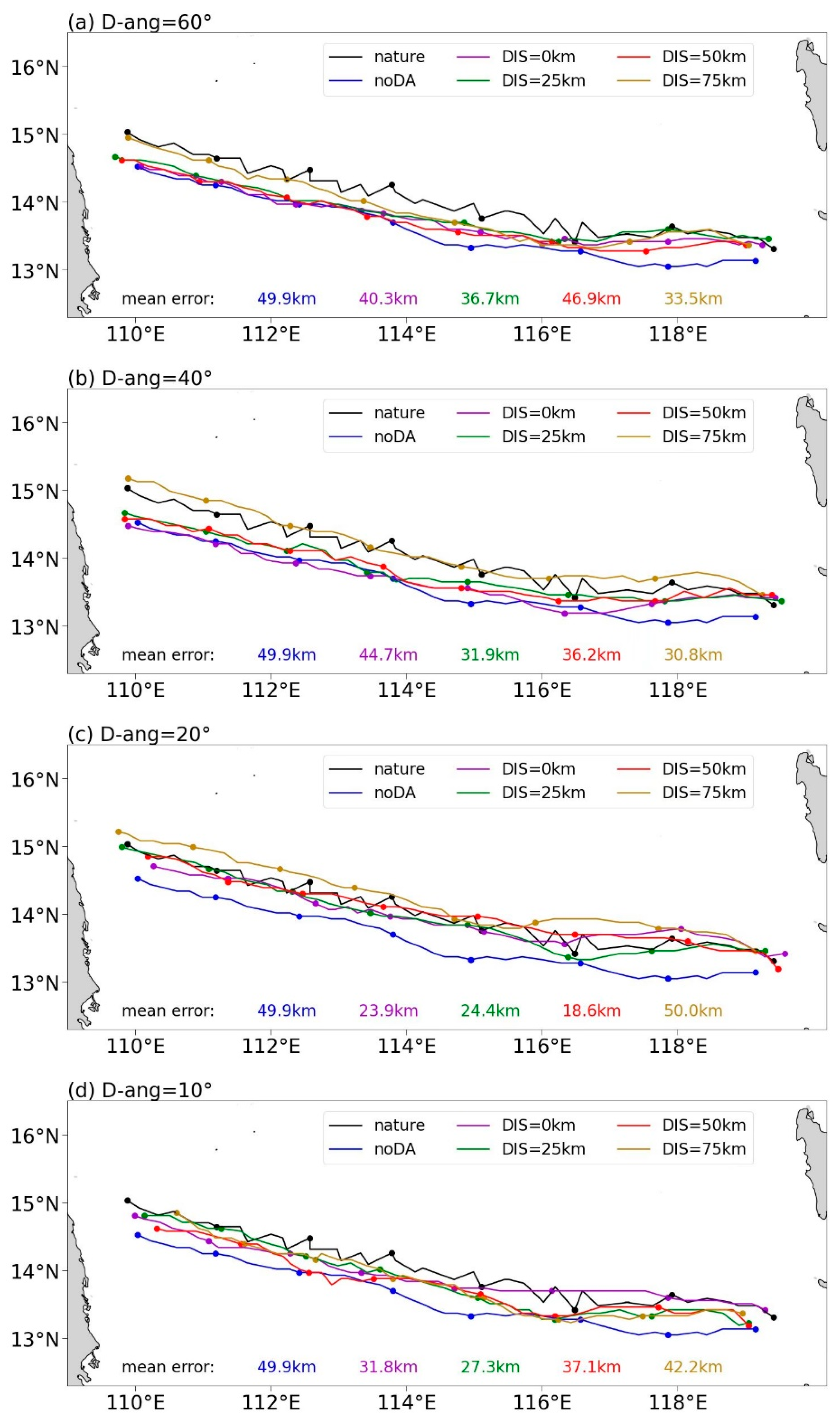
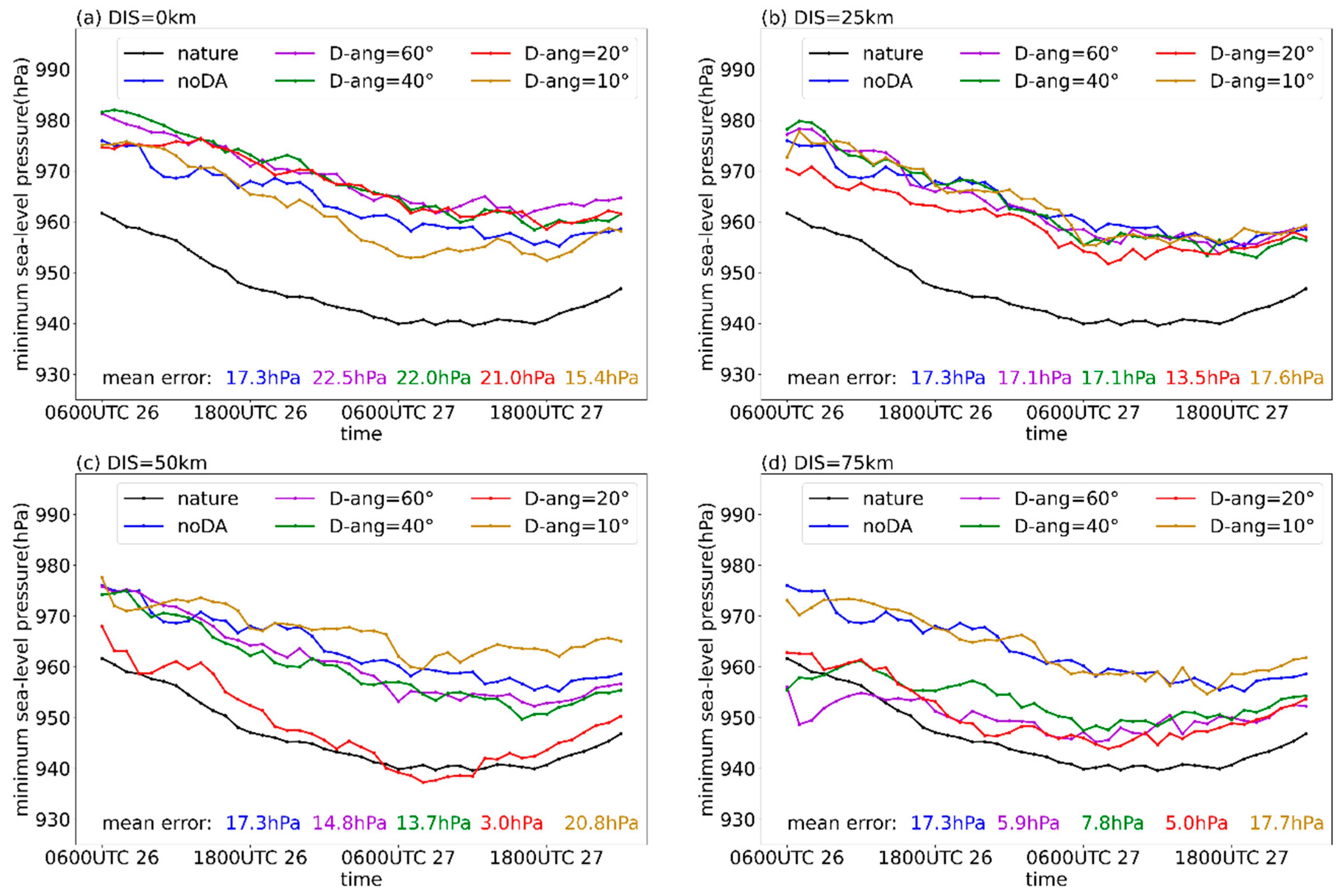
| Nature Run | EnKF/noDA | |
|---|---|---|
| Vertical levels | 50, top at 10 hPa | 43, top at 50 hPa |
| Grid nesting | Three two-way nested domains (d01/d02/d03) | |
| Horizontal resolution | 18 km/6 km/2 km | 40.5 km/13.5 km/4.5 km |
| Domain grid size | 311 × 251, 271 × 271, and 211 × 211 | 120 × 100, 151 × 151, and 169 × 169 |
| Planetary boundary layer | Yonsei University (YSU) scheme [49] | |
| Longwave radiation | Rapid radiative transfer model (TTRM) longwave radiation physics scheme [50] | |
| Shortwave radiation | Dudhia shortwave radiation physics scheme [51] | |
| Microphysics | WRF single-moment six-class microphysics (WSM6) scheme [52] | |
| Cumulus | Kain–Fritsch cumulus scheme [53]. | |
| D-ang (θ) | L (km) | R (km) | H (km) | Total SO Number |
|---|---|---|---|---|
| 60° | 23.1 | 11.5 | 20.0 | 431 |
| 40° | 31.1 | 23.8 | 20.0 | 575 |
| 20° | 58.4 | 54.8 | 20.0 | 1079 |
| 10° | 75.0 | 73.9 | 13.0 | 1367 |
Disclaimer/Publisher’s Note: The statements, opinions and data contained in all publications are solely those of the individual author(s) and contributor(s) and not of MDPI and/or the editor(s). MDPI and/or the editor(s) disclaim responsibility for any injury to people or property resulting from any ideas, methods, instructions or products referred to in the content. |
© 2022 by the authors. Licensee MDPI, Basel, Switzerland. This article is an open access article distributed under the terms and conditions of the Creative Commons Attribution (CC BY) license (https://creativecommons.org/licenses/by/4.0/).
Share and Cite
Feng, J.; Duan, Y.; Liang, X.; Sun, W.; Liu, T.; Wang, Q. QuickOSSE Research on the Impact of Airship-Borne Doppler Radar Radial Winds to Predict the Track and Intensity of a Tropical Cyclone. Remote Sens. 2023, 15, 191. https://doi.org/10.3390/rs15010191
Feng J, Duan Y, Liang X, Sun W, Liu T, Wang Q. QuickOSSE Research on the Impact of Airship-Borne Doppler Radar Radial Winds to Predict the Track and Intensity of a Tropical Cyclone. Remote Sensing. 2023; 15(1):191. https://doi.org/10.3390/rs15010191
Chicago/Turabian StyleFeng, Jianing, Yihong Duan, Xudong Liang, Wei Sun, Tao Liu, and Qian Wang. 2023. "QuickOSSE Research on the Impact of Airship-Borne Doppler Radar Radial Winds to Predict the Track and Intensity of a Tropical Cyclone" Remote Sensing 15, no. 1: 191. https://doi.org/10.3390/rs15010191
APA StyleFeng, J., Duan, Y., Liang, X., Sun, W., Liu, T., & Wang, Q. (2023). QuickOSSE Research on the Impact of Airship-Borne Doppler Radar Radial Winds to Predict the Track and Intensity of a Tropical Cyclone. Remote Sensing, 15(1), 191. https://doi.org/10.3390/rs15010191






